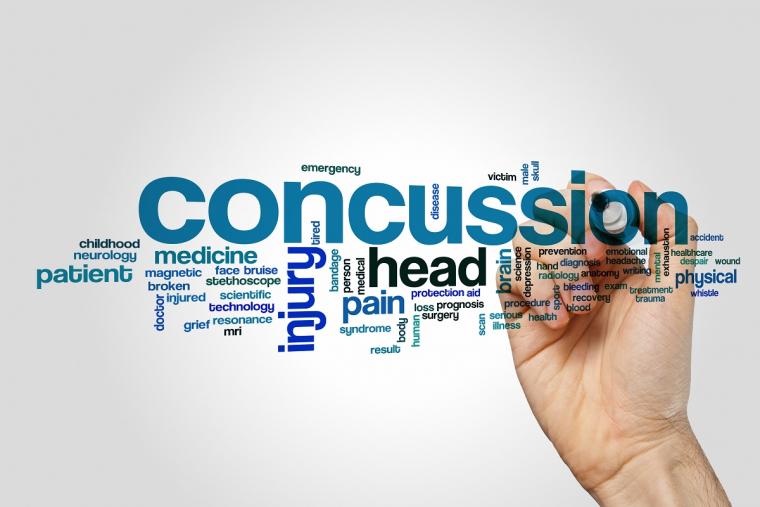
Doctors might soon be able to diagnose concussions based on “telltale signs” in a patient’s gut.
That’s right: A recently published study by researchers at Houston Methodist suggests that analyzing blood, stool and saliva samples can track the impact of concussions and signal when it’s safe for athletes to return to play. The findings were published in the May issue of Brain, Behavior, & Immunity — Health, a peer-reviewed journal of the Psychoneuroimmunology Research Society.
While brain movement within the skull may cause injury to nerve cells, such microscopic cellular injuries are not visible on imaging tests like X-rays, CT scans and MRIs — which are more capable of finding injuries on the scale of skull fractures, brain bleeding or swelling. The most commonly used test for diagnosis of concussions relies exclusively on self-reported symptoms like blurry vision, dizziness, nausea and headaches, researchers say, which can be vague, subjective and often underreported by athletes who want to continue playing.
 The Houston Methodist study relied on samples from 33 Rice University football players over the course of one season. Researchers examined the diagnostic potential of the gut’s microbiome and found a post-concussion drop-off of two bacterial species normally found in abundance in stool samples of healthy individuals. It also found a correlation between traumatic brain injury-linked proteins in the blood and one brain injury-linked bacterial species in the stool.
The Houston Methodist study relied on samples from 33 Rice University football players over the course of one season. Researchers examined the diagnostic potential of the gut’s microbiome and found a post-concussion drop-off of two bacterial species normally found in abundance in stool samples of healthy individuals. It also found a correlation between traumatic brain injury-linked proteins in the blood and one brain injury-linked bacterial species in the stool.
According to Sonia Villapol, one of the study’s author and an assistant professor of neurosurgery at the Center for Neuroregeneration at the Houston Methodist Research Institute, there have been dozens of brain injury biomarkers identified over the years, yet there has been limited success in developing commercial blood tests sensitive enough to detect tiny increases in biomarker concentrations. However, the central nervous system also is intimately linked to the enteric nervous system in the intestines, and head trauma invariably leads to changes in the gut microbiota, Villapol said.
Only four of the 33 football players in the study were diagnosed with major concussions, and Villapol says results will need to be confirmed in a larger sample size. Researchers also plan to conduct a similar study with women’s soccer players — as men and women do not have the same immunities or gut microbiomes.
“Until your gut microbiome has returned to normal, you haven’t recovered,” Villapol noted in a statement. “This is why studying the gut is so useful. It doesn’t lie. And that is why there is so much interest in using it for diagnostic purposes.”
In other concussion-related news:
• USA Rugby and TeachAids, a nonprofit innovator in global education, have teamed up to promote evidence-based concussion education. TeachAids — which has introduced HIV/AIDS health education in 82 countries and a CovidDB education initiative — also has developed the CrashCourse multisport concussion-education product suite in collaboration with world-class medical, sports and education experts.
“The safety of our athletes in a contact sport is the highest priority of our programs worldwide,” Jamie McGregor, USA Rugby Director of Training & Education, said in a statement. “We are excited to launch the CrashCourse curriculum to help equip our athletes and coaches with further knowledge of how to address head injury and to enhance our existing concussion education efforts.”
There are three elements to the CrashCourse training: a Brain Fly-Through, a Concussion Education module, and a Concussion Story Wall. Information about all three can be found here. These products, according to USA Rugby and TeachAids, aim to raise awareness of the latest science around concussions to shift the conversation away from fear and silence toward knowledge and empowerment.
“When you have surgery on your ACL, your doctor doesn’t then say, ‘Your ACL is fixed, off you go!’ But we do that with the most vital organ in the body,” Scott Anderson, the medical advisor for TeachAids who served as Director of Athletic Training and Sports Medicine at Stanford University for 10 years, told GoffRugubyReport.com. “Unlike a broken bone or a dislocation, or even a sprain that makes an athlete wince, concussions are invisible. You can’t see it, you can’t touch it, you can’t really feel it. And so you can convince yourself that you’re OK. There’s also a reluctance to talk about it. … There’s the fear that others will see you as slacking off or letting down your teammates. Athletes think there is a lot to lose by disclosing a concussion, whereas, in fact, there is much more to lose by hiding it.”
CrashCourse concussion education is available free to the public through the USA Rugby website, as well as to USA Rugby members through the USA Rugby Learning Center.
• Researchers in New Zealand have found that “women tend to experience more long-term negative impacts from mild concussions than men,” according to MedicalXpress.com. A team comprised of representatives from the University of Waikato, Auckland University of Technology and the University of Auckland analyzed individuals who suffered one or more concussions in 2010 and 2011.
“They found 1,298 people who had experienced a mild [traumatic brain injury], of which just 346 had completed a survey regarding their symptoms and 151 of those who had completed a follow-up survey eight years later,” MedicalXpress.com reports. “In looking at the data, the researchers found that approximately one-third of those who had completed the second survey reported experiencing negative associated symptoms eight years later. They also found something unexpected; women seemed to fare worse than men. Women with mild TBI events were twice as likely to experience PTSD or other health problems that they believed were related to their concussion, than were men. They also found that women who had experienced more than one TBI event were more adversely impacted than were men who had multiple events or women who had experienced only one event.”
The research was published on the open-access site PLOS-ONE.
• A Rutgers University study raises questions about the widely used Sport Concussion Assessment Tool (SCAT). SCAT is a questionnaire used by medical professionals that accompanies other methods to diagnose concussions sustained during athletic play. Researchers, who presented their findings at the American Physiological Society’s annual meeting in April, suggest that SCAT might be overestimating the condition and wrongly identifying such symptoms as fatigue and neck pain caused from intense exercise — and not a brain injury.
“While players with a head impact may report more symptoms generally, we have to be cautious in using all symptoms on the assessment since some are common after intense exercise even when there was no head impact,” the study’s first author, Stephanie Iring, a doctoral candidate in the laboratory of Jorge Serrador, an associate professor at Rutgers New Jersey Medical School and at Rutgers School of Health Professions, said in a statement.
In previous studies involving SCAT, researchers compared symptoms in athletes who experienced a blow to the head with people who had been at rest. For the new study, researchers compared SCAT scores in rugby players who had sustained a blow to the head with teammates who had just played an intense rugby match but did not have a head impact. They assessed 209 players — 80 of whom had experienced a head impact and 129 who had not.
Compared with those who did not suffer a head injury, those who did have a head injury had significantly more symptoms on the SCAT assessment, reporting 26 symptoms on average. Non-injured players reported about nine symptoms. However, many players without a head injury had symptoms similar to those reported by head-injured players, including fatigue and neck pain.
“Our data shows that exertion during a match increased the number and severity of self-reported symptoms in control players even though they had not experienced a head impact,” Iring said. “This could lead to difficulty differentiating these players from those that had experienced a head impact when using on-field assessments.”

